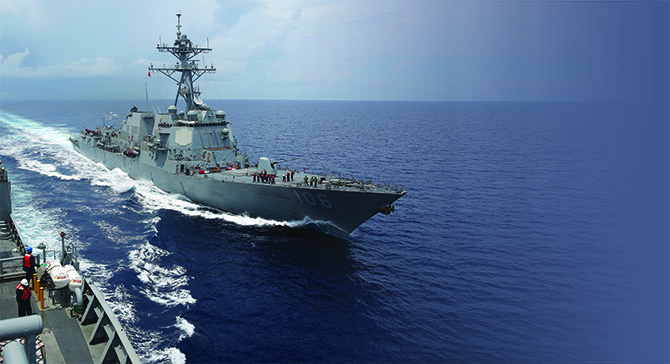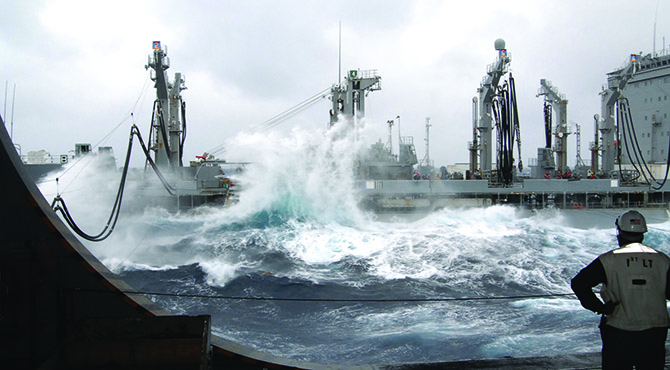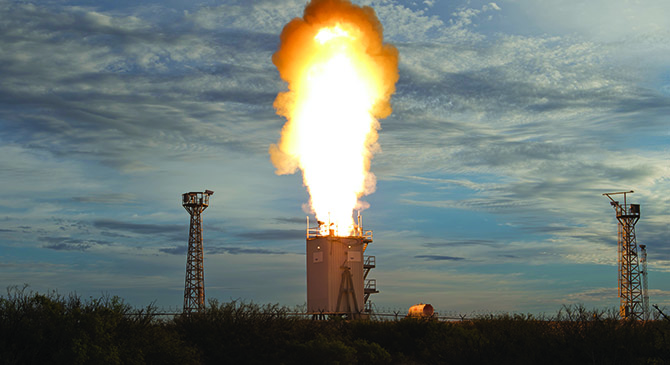
Over the summer, two tragedies took the lives of 17 sailors on board the USS Fitzgerald (DDG-62) and USS John S. McCain (DDG-56). These accidents were preceded by the grounding of the USS Antietam (CG-54) and the collision of the USS Lake Champlain (CG-57) with a South Korean fishing boat.
The root causes of these accidents were mistakes resulting from deviation from established watch standards, direction, practices, and procedures, and we are addressing how our watch teams are planning, practicing, and executing safe navigation practices. That being said, the accidents also brought to light questions the Navy and the surface force must address, particularly regarding the balance between the production and consumption of readiness at the force level. Senior leaders—both civilian and uniformed—have scrutinized the accidents and their causes. As a Navy, we are committed to addressing the specific issues contributing to the collisions, as well as the larger issues at hand.
There is much to be proud of in surface warfare, but we must do better to address systemic factors as we strive to better train shiphandlers and watchstanders.
Readiness
Two essential processes are at work in today’s surface force: the production of readiness and the consumption of readiness. No matter where a ship is homeported, she is either generating readiness through maintenance, modernization, and training or she is consuming it with operations at sea.
The production of readiness is a function of many inputs tied closely to available resources. These inputs include proper manning and manpower on our ships—that is, both the right number of people and the right skill sets; sufficient manning in shore-based training organizations, again, in both numbers and skills; a robust maintenance support function; regularly scheduled modernization; and properly manned and resourced command and oversight organizations.
The consumption of readiness is the purview of operational commanders, primarily the numbered fleet commanders. Their responsibilities have increased substantially in the past few decades, as a Navy that in 1989 routinely had 100 of its nearly 600 ships under way has evolved into a 277-ship Navy with 100 ships routinely under way. This is compounded by mounting threats to U.S. security interests, including a powerful China, a newly emboldened Russia, an unpredictable North Korea, an Iran bent on regional dominance, and an ever-present threat of terrorism.
The failure to adjust Navy operational culture and habits to the reality of a greatly reduced force size has been further complicated by reductions in our readiness production capacity. Budget reduction decisions, made to balance competing priorities in a time of need or to gain efficiency, can create additional and unforeseen risks to our capability and capacity. In addition, these risks are not conceptualized in real time and can take a decade or more to recover from if and when further resources are applied later in the requirements process.
Much has been made of Vice Admiral Phillip Balisle’s 2010 inquiry into surface force readiness, the prioritization of efficiency over effectiveness, and its critical assessment of the state of manpower, training, and maintenance in the surface force of that day.1 Some even assert that its findings were ignored.2 This misconception is understandable given the often considerable lag between when required resources are identified and when they are applied to readiness shortfalls.

Fitzgerald and John S. McCain
While there is a good deal of focus being placed on the degree to which mission qualifications had been waived in the Japan-based Forward Deployed Naval Force (FDNF), both the Fitzgerald and John S. McCain had demonstrated the minimum requirements for getting under way and conducting routine operations.
In each collision, known and understood direction—whether from the commanding officer or technical authorities—was ignored or disregarded by watchstanders. In each case, there were notable deviations from standard operating procedures. Do such deviations occur as the result of systemic failures in the production of surface ship readiness at a force level? If so, how? What is the transmission path of the error that begins as a mismatch of supply and demand resources at the fleet level and ends up with a qualified officer of the deck not making required reports to the commanding officer?
This question is difficult, if not impossible, to answer, because the “dots” do not necessarily connect. Regardless of whether a systemic failure is demonstrated across the fleet, we must be critical of all the policies, procedures, and schools we use to man, train, and equip the fleet. This is a complex process and requires synchronization across the community and Navy to ensure both unit-level proficiency and force-level support are improved to achieve the readiness and warfighting proficiency our nation demands and our sailors deserve.

Comprehensive Review
On 2 November 2017, Chief of Naval Operations (CNO) Admiral John Richardson released the findings of a panel led by Admiral Philip Davidson, Commander, U.S. Fleet Forces Command, that reviewed the state of readiness of the surface force and how that readiness interacted with the specific circumstances involved in the incidents of 2017. In his findings, Admiral Davidson identified gaps in doctrine, organization, training, material, leadership and education, personnel, and facilities. For example:
[I]n doctrine, the review found weaknesses in the way operational tasking is prioritized and issued to Japan-based ships; in organization, variances were identified in headquarter staffs and the manner by which they execute command and control and manage the readiness of assigned forces; in training, gaps were noted in the way seamanship and navigation skills are provided and assessed for individuals and teams on surface ships; for material, inconsistencies and gaps were found in the configuration control and oversight of bridge navigation systems; in leadership and education, deficiencies were noted in the leader’s ability to identify, mitigate, and accept risks, and then learn rapidly from near-miss events and other hazards; in personnel, gaps were identified in the qualification and proficiency of the surface force in seamanship and navigation; and in facilities, gaps were identified in the shiphandling trainers and associated shore-based infrastructure in place to support training for seamanship and safe navigation at sea.3
The panel’s report categorizes these gaps in five key areas or tenets:
(1) Fundamentals. Basic skills such as seamanship and navigation, rigor in individual qualification processes, proficiency, and adherence to existing standards.
(2) Teamwork. The extent to which the surface force deliberately builds and sustains teams, and whether they are tested with realistic and challenging scenarios.
(3) Operational Safety. The process and tools by which ships are made ready for tasking, ships are employed, and technology is used to safely operate at sea.
(4) Assessment. The extent to which ships and headquarters plan, critically self-assess, generate actionable lessons learned, and share knowledge across the force.
(5) Culture. The sum of the values, goals, attitudes, customs, and beliefs of the surface force that defines its identity.4
The report speaks to these five tenets, noting that its key findings and recommendations “are intended to instill the needed capabilities and proficiencies to make the surface force safer and more effective.”5 The conclusions contained in the report are an important start to revitalizing the professionalism of the surface force and reestablishing warfighting excellence on a base of sound and fundamental competence.
Surface Force Actions
To address deficiencies in readiness, the surface force is pursuing the following initiatives. Some are under way, and some are undergoing additional shaping before implementation. In addition to addressing some of the big-picture systemic issues, we seek to build better mariners through adjustments to career paths, additional targeted training, and a reemphasis on the profession of surface warfare.
• Commander, Naval Surface Forces Western Pacific. We created a forward-deployed command with the sole purpose of overseeing the production of readiness in FDNF, Japan. It is acting as an honest broker between readiness production and consumption. This command not only will be the advocate for forward-deployed readiness, but also will be manned so it can perform readiness oversight of FDNF ships between certifications. For much of the Cold War, readiness and operations functions were separated in the surface force, and in the period following the Cold War—when efficiency grew in importance relative to effectiveness—destroyer and amphibious squadrons took on both readiness and operational responsibilities. We increasingly see value in splitting those functions again, especially where FDNF (Japan, Rota, and Bahrain) ships are concerned.
• Circadian Rhythm–based Watch and Work Routines. The role exhaustion played in the four incidents in 2017 varies from ship to ship; however, there is no debate about the wisdom of implementing circadian rhythm–based watchbills and shipboard routines on surface force ships to provide predictable, protected periods of sleep for our sailors and optimize alertness and recuperation. To that end, as of December 2017, all ships implemented circadian rhythm principles in their watchbills and shipboard routines. Ships with unique mission sets and manning constructs will incorporate circadian rhythm principles into their planning processes and battle rhythms.
• Standardized Standing Orders. The design commonality among our ships is far greater than the unit-level differences, yet the every commanding officer promulgates his or her own set of standing orders to watchstanders, battle orders that specify the configuration and operation of the ship’s combat system, and a doctrine for how the engineering plant is operated under conditions known as “restricted maneuvering,” which include underway replenishment, flight operations, piloting waters, and at battle stations. This variation adds a degree of uncertainty from ship to ship and detracts from the establishment of force-wide standards. To address this, the surface force is moving toward greater standardization to achieve greater certainty for operators. Individual ship configurations may require some variation from standardized type commander orders, but in all cases, a common set of high standards will be followed.
• Automatic Identification System (AIS) Operations. AIS is a location and identification system employed extensively by commercial vessels but that characteristically has been used in “receive only” mode on board U.S. Navy ships. Unless there is a valid overriding operational requirement, all surface force ships now employ AIS in full two-way mode when operating in restricted waters and in high-traffic areas such as where both the Fitzgerald and John S. McCain were operating at the time of their collisions.
• Ready-for-Sea Assessments. We are conducting ongoing assessments of our ships’ ability to safely navigate, communicate, and operate, as well as assessing the critical mission areas of navigation, propulsion, steering, communications, and damage control. These assessments have the authority to rescind an existing certification if necessary or, if deficiencies are less severe, to direct remedial training on a priority basis. The assessments first focused on FDNF, Japan, and now are being conducted on all surface force ships.
• Elevation of Reporting on Navigation Equipment. Any casualty to critical ship-controlling equipment/systems affecting navigation, steering, propulsion control, and/or installed damage-control equipment will be reported as category (CAT) 3 casualty reports, unless the Joint Fleet Maintenance Manual rules dictate CAT-4 (which is the most serious degradation).
• Near-Miss Reporting. All ships will report, evaluate, and train to lessons learned from incidents and near misses. Formal requirements were provided to the surface force to engender safe, professional shipboard operations through the conduct of significant event/near-miss critiques, which will improve surface force safety by disseminating the reports from this process. The reporting will instill a culture of continuous improvement, promote better understanding of sound shipboard operating principles, and provide proficiency in root cause analysis to improve warfighting effectiveness.
• Bridge Resource Management (BRM) Workshop. This initiative leverages the extensive knowledge, experience, and certifications (e.g., Master Mariner and Standards of Training, Certification, and Watchkeeping for Seafarers) of the Navy’s strategic sealift officers in conjunction with post–department head surface warfare officers to provide an at-sea validation of BRM skills on the bridge and in the combat information center. This mobile team will be able to evaluate ships in all Navy operational areas throughout the training and certification cycle. The first pilot workshops on West Coast guided-missile cruisers and destroyers have been completed, with the next phase of workshops taking place on FDNF, Japan, ships this month.
These actions and guidance will help the surface force revalidate core competencies, enhance operating proficiency, and navigate and communicate safely and will bolster the confidence of our sailors, our military and civilian leadership, and the American public whom we proudly and faithfully serve. We must do more to build surface warfare officers who are as well trained in seamanship and navigation as they are in tactics. This will require a change to the way we conduct initial accessions and training for new ensigns detailed to our ships. Recent incidents remind us that any moment at sea has the potential to be a critical moment—requiring confident, decisive, and well-trained action. As a community, the surface force is committed to making the course corrections necessary to safely conduct operations at sea.
What is at Stake?
The need for improvement at every level of surface warfare cannot be overstated, because the consequences of undershooting the mark are stark. The capability, capacity, flexibility, mobility, and endurance of surface forces is the core of our nation’s ability to regulate the peacetime security environment and provide regional, conventional deterrence. The soon to be promulgated “Distributed Maritime Operations” concept—which describes the naval force as “the fleet-centric warfighting capabilities necessary to gain and maintain sea control through the employment of combat power that may be distributed over vast distances, multiple domains, and a wide array of platforms”—will succeed only with a powerful, networked, and capable surface force as its backbone.6 That fundamental strength must be built on a foundation of professionalism and competence.
In the surface force, we have spent three years developing, analyzing, and implementing the operating concept of distributed lethality, first described in the January 2014 Proceedings.7 In that time, support for a more lethal and distributed surface force has grown throughout the Department of Defense, with significant investment in platforms, sensors, weapons, and networks designed to make surface ships harder to find, harder to kill, and more lethal. These investments include missiles that allow enemy ships to be killed at greater range (Standard Missile-6, Tomahawk Land-Attack Missile SUW), offensive enhancements to existing ships (LCS over-the-horizon missile), a more capable small surface combatant (FFG[X]), and networking approaches to integrating the Marine Corps F-35B with our Aegis fleet. In addition, the Future Surface Combatant (FSC) project led by the OpNav Directorate of Surface Warfare is charting the course for surface combatants that will replace ships getting to the end of their service lives, including cruisers, destroyers, and early stage LCSs. The FSC program is using a revolutionary approach to discerning requirements by taking an architectural view of surface warfare rather than one that simply seeks to replace hulls. The networking of manned and unmanned surface ships guided by a netted combat command and decision system functioning both on the ships and on the network promises a future of powerful operations at machine speed, where hard- and soft-kill options are most efficiently pursued and where limited weapons are most thoughtfully allocated.
A New Sense of Purpose
We cannot lose sight of either the importance of what we do or the great skill and professionalism with which it generally is done. The areas identified for improvement are broad, and we will attack them with alacrity.
During my recent trips to the waterfront, I have seen a new sense of purpose, a rededication to tactics and warfighting, and a grasp of how important it is for the surface force to be forward, powerful, and ready. We now must apply that same focus and enthusiasm to the professional requirements of sailing and steaming.
Every day, around the world, sailors of the surface force protect and sustain U.S. security and prosperity by their powerful presence, through which allies and partners are assured and would-be aggressors are deterred. The never-ending job of surface warfare leaders is to ensure every one of those sailors has the tactics, tools, talent, and training he or she needs to fight and win.
1. VADM Phillip M. Balisle, USN (Ret.), “Fleet Review Panel of Surface Force Readiness,” final report, 26 February 2010, www.scribd.com/document/43245136/Balisle-Report-on-FRP-of-Surface-Force-Readiness.
2. CAPT Kevin Eyer, USN (Ret.), “Collisions: Part 1—What Are the Root Causes?” Proceedings Today, August 2017, www.usni.org/magazines/proceedings/2017-08/collisions-part-i%E2%80%94what-are-root-causes.
3. U.S. Navy, “Comprehensive Review of Recent Surface Fleet Accidents,” 2 November 2017, 6-7, https://news.usni.org/2017/11/02/document-navy-comprehensive-review-surface-forces.
4. Ibid., 8.
5. Ibid.
6. Navy Warfare Development Command, “CNO Visits Navy Warfare Development Command,” news release, 13 April 2017, www.navy.mil/submit/display.asp?story_id=99893.
7. VADM Thomas Rowden, RADM Peter Gumataotao, and RADM Peter Fanta, USN, “Distributed Lethality,” U.S. Naval Institute Proceedings 141, no. 1,343 (January 2015), www.usni.org/magazines/proceedings/2015-01/distributed-lethality.
Vice Admiral Rowden is Commander, Naval Surface Forces/Naval Surface Force, U.S. Pacific Fleet.


